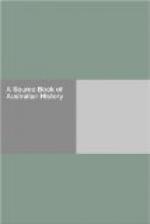“The walls of this cane were exceedingly thick, giving it great stiffness, and solidity to resist storms of wind. It proved to be hardly so juicy as I expected.
“I understood you to say that these canes had been produced in eight or nine months from being planted, and without any particular care.
“Taking this for granted, there can be no question, I think, that with sufficient capital, and under efficient management, the cultivation of the cane for sugar ought to prove one of the most profitable arrangements which offer themselves in Australia, I mean at Maryborough, or other places equally well situated on the North-eastern coast. I have for many years thought that sugar plantations to the northward of Moreton Bay ought to be highly remunerative. The climate is favourable; there is no lack of good land, and unlike the Mauritius, we never hear of the ravages of hurricanes.”
3. The opinion of so high an authority as Sir William Macarthur coupled with a number of facts within my knowledge, leave no doubt in my mind that, when Capital and Labour shall have been introduced, the cultivation of sugar may be carried on in this colony, with at least equal success as at Mauritius, and on a vastly more extensive scale than in that island.
4. I beg to subjoin a short description of the district of Wide Bay, or Maryborough (referred to above) condensed from a recent publication by a writer of local knowledge and competent authority.
The back country is extensive, its capabilities are so well known we need not dwell upon them. The soil on the branches of the River Mary and its tributary creeks, and within easy approach to the same is excellent and in large quantities. Its producing capabilities may be illustrated by the following facts: In one piece of ground may be seen growing in perfection the sugar cane, cotton plant, grasscloth plant, arrowroot, tascan wheat, yams, sweet potatoes, cassava, custard apples, pine apples, banana, guava, and many other tropical productions; alongside of which may be seen turnips, wheat, barley, mangel-wurzel, English potatoes, artichokes (Jerusalem), broad beans, maize, etc. At the same place a crop of maize (which was estimated to yield from 80 to 100 bushels to the acre) is in a forward state of ripening, and from the same piece of ground, three crops of maize have been gathered within the twelve months. Where is there another river in Australia with capabilities for the growth of such varied productions, each perfect of its kind, and such facilities for shipping, by vessels of the largest tonnage, the produce direct to any part of the world? Wheat has been only grown in small patches—each time, however, with success. Cotton was here produced in the same way from a few plants, and pronounced by competent judges to be of the finest quality both in staple and texture. Equally favourable results have been obtained with the other products named above. The particulars




